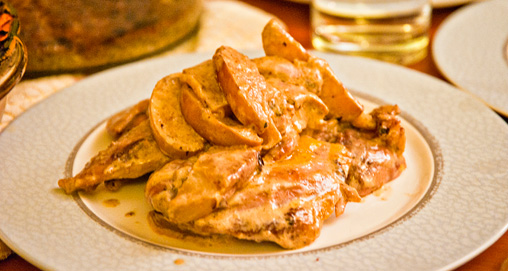
Photos and By Georgia Pellegrini
I recently hunted pheasant at Cheyenne Ridge Signature Lodge in Pierre, South Dakota. This beautiful place is the first sporting venue to ever receive a Beretta Trident rating. It is also one of only four in the United States that has been inducted into the Beretta Trident program, a kind of Michelin guide for hunting, which rates professional hunting ranches around the world and bestows upon them one to three tridents. It was an impressive experience, and if you love pheasant-its taste, its beauty and its mystery-this is a great place to visit. And they have an ice bar at the lodge to keep the scotch at the right temperature. Need I say more?
I have been cooking a lot of birds in preparation for my next book, and this recipe is one of my favorites. It is creamy, rich and sweet, and includes all of the things that go well with pheasant, namely apples and cream. Pheasant is hard to pluck and the skin is fragile, so it is unlikely that you will have a bird with protective skin. You can remedy this by covering the skin in bacon or another fat, like pancetta. This will serve as the "skin" and help prevent the bird from drying out.
Another way to ensure good flavor is to age the bird for up to seven days. The beautiful taste of a well-aged animal came by virtue of necessity. Refrigeration wasn't available until the 20th century, which meant that people learned to enjoy game birds whose breast meat was aged until green. But as my friend, a British gamekeeper, pointed out, people don't like their food "high" anymore. Their taste buds are no longer suited to it since the advent of refrigeration.
Certain game birds today, however, when relatively undamaged by shot, left in their feathers with intestines intact and aged for a period of time, are much better tasting. Unlike domestic animals, wild animals have that rich, variable flavor because they are often older at death, exercise freely and enjoy a mixed diet. The wild flavors that result from cooking these animals are often described as "gamey." In Brillat-Savarin's day, game was hung until it began to rot-a treatment they called mortification or faisandage (after the pheasant, faisan)-which not only tenderized the meat but heightened the "wild, gamey" flavor even further.
This concept makes today's eaters recoil. We are used to meat that is tender and very mild .(I would even suggest flavorless). This is because today's farmed animals live a very different lifestyle than their ancestors or wild counterparts-they are sedentary, eat a uniform diet and are slaughtered before they reach sexual maturity. It is not surprising then, that it takes a slightly different approach to properly cook a wild animal, and the secret lies in proper aging.
Aging is a change in the activity of muscle enzymes. At death, the enzymes begin deteriorating cell molecules indiscriminately. Large, flavorless molecules become smaller, flavorful segments; proteins become savory amino acids; glycogen becomes sweet glucose; fats become aromatic. All of this deterioration and break down of the cell molecules creates intense flavor, which improves further upon cooking, particularly slow braising.
Since any meat that is aged tastes so much better than meat that is not, it would seem logical that modern meat producers would age their meat-but they do not. It is simply a matter of lost time and economics-an unwillingness to tie up product in cold storage and lose 20 percent of the meat's original weight to evaporation in the name of taste. The number of days between slaughter and the dinner table are very few.
The good news is that home cooks can age meat in their own kitchen. With store bought meat, leave it uncovered in the refrigerator to allow for evaporation (in the case of roasts and other large cuts), or store it tightly wrapped (in the case of steaks and smaller cuts). After the extra aging, all you have to do is trim off any discolored or dry spots that occurred from drying and oxidation.
I recommend hanging a wild bird by the neck for four to seven days with the feathers and insides still in tact. When you finally go to pluck, you will find the insides are much more mild and the meat much more tender than if you had eaten it on the first day.
Give this a try sometime! You will never go back to chicken.
Pheasant with Roasted Apples (Serves 4)
1 whole pheasant, skin off or on
3-6 pieces bacon or pork fat, cut into 1/8 inch thick strips
2 tablespoons butter
2 large apples, cored and sliced into ¼ inch wedges
1 tablespoon Calvados
7 tablespoons heavy cream
Salt and pepper
1. Preheat the oven to 450 degrees F. Season the pheasant with salt and pepper. Truss the pheasant.
2. Melt 1 tablespoon of butter in a heavy-bottomed ovenproof pan, and brown the pheasant on each side, about 4 minutes. Remove pheasant from pan and put aside.
3. Add 1 tablespoon of butter to the pan and fry the apples quickly. Place them in the bottom of the casserole. Add lard to the pheasant across the breast, secure with toothpicks. Place the pheasant on top of the apples.
4. Cover the pan in tin foil or with a lid and put it in a preheated oven and immediately lower the temperature to 425 degrees F and cook for 30 minutes.
5. Five minutes before serving, pour 7 tablespoons of heavy cream and 1 tablespoon Calvados over the pheasant. Untruss it, carve into joints and serve very hot with the apples.





































